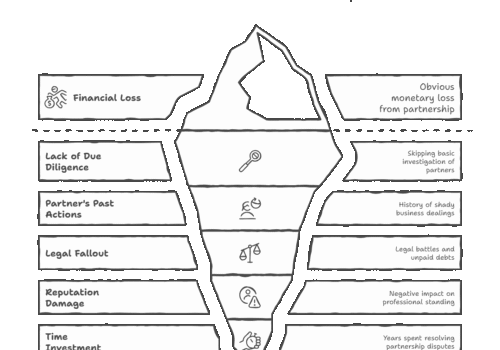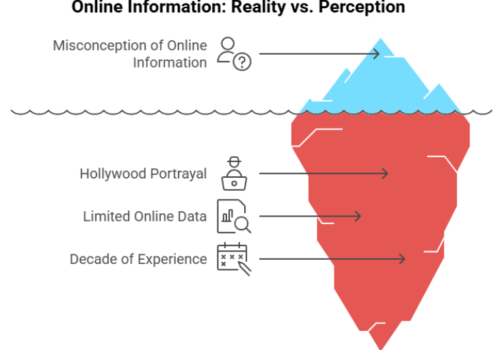How to Check If a Company is Legit: Your Scam-Proof Guide

The digital landscape? It’s booming. A true phenomenon, right? But unfortunately, where there’s growth, scams aren’t far behind. And believe me, they’re EVERYWHERE. The stats don’t lie. The Federal Trade Commission (FTC.gov) says consumers lost over ten billion dollars to fraud in 2023. Ten. BILLION. A massive amount of that, sadly, comes from online scams run by illegitimate businesses. That’s where I’ve come in, and, frankly, that’s why I wrote this article. I think the risk is understated.
For years, I’ve been on the front lines supporting businesses and individuals through the murky waters that you encounter when trying to figure out if a company is legit or not. My expertise lies in seeing red flags – often in plain sight, believe it or not – that separate a genuine enterprise from a potential ticking time bomb. I can’t stress this enough: verifying company legitimacy isn’t an option anymore; it’s just plain necessary to protect against scams. It’s essential for anyone with a financial well-being to protect. This guide? It’s designed to give you the tools to run business verification effectively.
Why Bother Checking?: The Real-World Risks
Beyond just being annoying, what’s the worst that can happen from dealing with illegitimate businesses?
Financial Losses and Legal Trouble
The consequences of getting mixed up with shady companies? They really go WAY beyond simple disappointment. Business fraud can lead to severe financial losses, from unpaid invoices piling up to just outright theft, and, man, I’ve seen some brutal cases. I’m not exaggerating. Beyond that, getting involved with these kinds of businesses can expose you to serious legal problems, especially if they’re involved in… well, let’s just say illegal activities.
I recall a case a few years back involving a small manufacturing client. They were about to sign what looked like a hugely promising contract with a new supplier. Yet something felt….off. They asked for my advice, and it was amazing they did. After a little investigation, I saw that the supplier was really just a shell company deep into money laundering! Identifying that supply chain risk literally saved my client millions in potential losses…and honestly, some major legal headaches too.
The Obvious Red Flags: Spotting Scams Early
Okay, so where do you actually START the process of sussing out whether a company is legit?
Website Warning Signs
One of the first places I go to check for a company’s legitimacy? Their website. Think of it as their public face. It’s usually the easiest piece of the puzzle to start with. A scam website often shouts red flags… like, obvious ones. For example, I start getting immediately suspicious of sites that are just bursting with poor grammar, spelling errors, etc. To me, that screams lack of detail, or just someone trying to throw something together super fast to trick folks.
Another red flag? An unprofessional website design. Or, worse, one that looks super outdated. Legitimate businesses? They’re going to spend money to make their online image look polished and inviting, right? Also, look very closely for contact information! A real company is going to have various clear and easy ways to reach them – physical address, phone number, email. If you’re just seeing vague contact forms… or just generic email addresses? Be extra cautious.
And finally, pay really close attention to the exact domain name. Shady sites often use strange extensions – like .xyz or .biz. Or – and this is crafty but obvious once you see it – will slightly misspell a big brand name to trick people. Like amazoon.com instead of amazon.com. My basic rule of thumb for people that aren’t sure? If the website seems amateurish or incomplete, step very carefully.
Deep Dive: Checking Official Records & Databases
Okay, let’s say the website isn’t a total train wreck, but something still just feels off. Now what?
State Business Registries
While website checks are a great first step, they’re definitely not enough on their own. Really verifying the business? That means looking at official records. Almost every state has their own registry for businesses running in the state. These registries? They’re treasure troves of information! You’ll see the company’s legal name, their business registration date, who their registered agent is, and their status – active, inactive, etc. And to find these databases you can often do a business verification. It usually starts with going to the state’s Secretary of State website.
Using these databases is usually fairly straightforward if you know where to look. Find the Secretary of State’s website for whatever state the company claims to be registered in. Most of those state websites have a “Business Search” or “Entity Search” function… just find it and go there. For example, if you’re in California, just go to the California Secretary of State’s website (sos.ca.gov): and do a business search. And if you’re having trouble and would like to do something else, switchonbusiness.com has a useful directory of business search pages for all 50 states. Neat!
I had a client once considering investing in a franchise opportunity, and he was pretty excited about it. It seemed legit at first glance. However, just a super-quick check of the state business registry basically showed that their registration had expired years ago! Just being aware of that information really made him think twice about investing and saved him from what could be a disastrous headache.
Digital Footprint Analysis: Website, Social Media, and Online Reviews
Okay, so you’ve seen their website, and you’ve checked the official records. What else can you do to piece together the puzzle?
Analyzing Social Media Presence (or Lack Thereof)
It sounds almost silly since it’s so common, but in today’s world, the social media presence – or lack of presence – of a company can be extremely important. It’s fertile ground for social media verification. A legitimate company will usually have active social media accounts on whatever platforms make sense for their market. They usually have some branding, clear posting, and, very importantly, active engagement going on with their followers. I will always tell clients to notice if brands are consistent across different platforms – look for the same logo, the same color patterns, and, of course, similar messaging.
But just having an account isn’t enough! Be careful of profiles that have too many followers but too little engagement (likes, comments, shares). Those are often just… bots. Also, keep an eye out for the opposite problem: social media accounts that were created only recently or have a VERY limited number of old posts. I’ve seen several scam cases relying on accounts like that.
Spotting Fake Online Reviews: What to Look For
Okay, let’s face it: online reviews are critical to your decision making these days! They are a valuable source of information, but you can’t just mindlessly accept everything you see. Fake reviews are rampant, and that can unfairly skew how you see a given company. When I’m doing online review analysis, I’m always checking for clear patterns – are the reviews either overwhelmingly positive, or overwhelmingly negative, with hardly any realistic nuance mixed in? Are they using just generic language? Repeating the same phrases? Those could be indications of fake or inauthentic information.
It also helps to remember this to help online review analysis: be suspicious of reviewer profiles that have no picture, little activity, or, and this is common, just seem to only post either positive ones or negative ones. You could also seek tools to assist in figuring out potentially fake or suspicious review patterns. For example, Fakespot analyzes reviews in places like Amazon (or just other e-commerce sites) to look for fake testimonials. Another trick? Read the reviews until you see the ones with particular details involving whatever product happens to be the topic. Legit reviews should have realistic details that are true to the item.
Reverse Image Search: Unmasking Stolen Content
Okay, time to bring out a relatively obscure but POWERFUL tool!
Identifying Stolen Logos and Product Images
A fantastic, but often overlooked, method for verifying company legitimacy has to be the reverse image search. This tech can help you figure out when an enterprise is using someone else’s visuals/logos and you will notice that their images are stolen and on their site as well!
It’s a quick process when checking fraud/stolen digital content!
Here’s the quick and dirty on how to do it:
- Save the Image: Right-click on their logo. Right-click on an image. Right-click. Right click until you save the images to your files!
- Use Google Images: Access Google Images (images.google.com). Find the camera icon.
- Upload or Paste: Just upload/use files with a Google Image, and you’re set.
- Analyze Results: Google, by the looks of it, will start to display the ones from across the World Wide Web! If that image belongs to a high-profile company, this scam attempt seems like a pretty high indicator since their logo or product is being stolen.
For the logo process and verification method, you can gain a unique insight when utilizing that!
I do remember in this one scenario; a client considered doing a franchise. They had outstanding photos of their restaurant’s location! However, I did an image run on their photos, and I found they were taken from STOCK and weren’t even related at all to the franchise; that immediately rose a massive red flag; the client bailed!
Contacting Them Directly: Testing Responsiveness & Knowledge
So you’ve got a lot of clues so far. It’s time to engage directly.
Asking the Right Questions
Sometimes, the outright best way to figure out if a company is legit is to just contact them. It lets you confirm their contact itself and, of course, assess what they do. Direct testing and verifying is something that can benefit you highly!
However, to note, you will have to contact them the RIGHT WAY! And that means a couple of questions:
- “What is/are your business registration number(s), and by what state were you registered by?” They are most likely legit if they are fast to provide you these facts.
- “What is your company’s main mission?” It all starts with knowing their mission and what they wish to set out to do.
- “Who are your main clients?” If they will and/or are able too, find this answer out to see who their main clients are.
- “What are your refund policies?” This can serve as a guide if you plan to initiate the purchase of that item.
You’ve probably noticed the need to find the answers/feedback necessary to proceed! But also confirm if they’re doing it in a prompt and professional way, and be wary of vague or questionable answers!
Common Scams and How to Avoid Them
One of the most damaging things from being illegitimate? Is it a scam? The scams that follow must be learned about in order to ensure total safety!
The Anatomy of a Scam
Knowledge and understanding can only make you stronger! It will make you better. Let’s note! With an “advance-fee” scam, you will get nothing. Whether it’s a phony reward or a job that promises to pay a lot, watch for an upfront promise, you have to contribute money.
With scams involving IRS details, scammers will trick you to see your social security number, banking details or even your phone number! Be worried about that. Scare tactics is one way scams are activated.
Recently, a scam can get to your head if you get some messages on bad delivery of your item! In order to fix it, you need address and billing updates!
My expertise of fighting online fraud: all I’ve gained over the years can confirm how important skepticism means, in order to avoid fraud. Confirm and check how legitimate the user is, and do not believe anything you may be told over any form of communication.
Having a presence online, ultimately, is a risk. But it does not mean you can’t stay safe! Here is an idea: verify everything with something like the website read flag checks and the reverse image results. Always create something to help you stay safe with exploring the risks!
Staying Vigilant in a Risky World
Remember, I hope this ensures you to do business with safety, and that is my own goal, to make you stay safe from fraud. The next time you’re asked to explore a company or partner, spend some time to apply what you just learned now.



